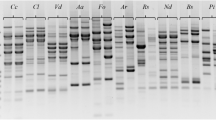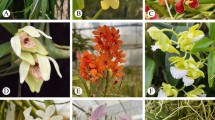Abstract
The genus Paspalum is characterized by over 400 species that are indigenous to a wide range of stressful habitats and marginal environments. Fifty-one accessions representing 29 Paspalum species were analyzed for DNA restriction fragment length polymorphisms (RFLPs). Fifteen random genomic probes were used in combination with restriction enzyme EcoRI to detect RFLPs, and data were analyzed phenetically. Hybridization with the 15 selected clones resulted in the detection of 261 RFLPs. Among the 261 restriction fragments scored, 204 (78.2%) were phenetically informative. Extensive RFLP variation was found between the species studied. Species affinities based on RFLP data were found to be in close agreement with previously determined relationships based on both morphological and cytological characteristics.
Similar content being viewed by others
References
Burkhart, A., J.A. Caro, K.A. Okada, R.A. Palacios & Z.E.R. Agrasar, 1969. Flora Illustrada de Entre Rios (Argentina): Part II, Gramineas. I.N.T.A. 4, Buenos Aires.
Burson, B.L., 1978. Genome relations between Paspalum conspersumand two diploid Paspalumspecies. Can J Genet Cytol 20: 365-372.
Burson, B.L., 1979. Cytogenetics of Paspalum urvillei× P. intermedium, and P. dilatatum× P. paniculatumhybrids. Crop Sci 19: 534-538.
Burson, B.L., 1981. Cytogenetic relations between Paspalum jurgensiiand P. intermedium, P. vaginatum, and P. setaceumvar. ciliatifolium. Crop Sci 21: 515-519.
Burson, B.L., 1991a. Homology of chromosomes of the X genomes in common and Uruguayan dallisgrass, Paspalum dilatatum. Genome 34: 950-953.
Burson, B.L., 1991b. Genome relationships between tetraploid and hexaploid biotypes of dallisgrass, Paspalum dilatatum. Bot Gaz 152 (2): 219-223.
Burson, B.L., 1992. Cytogenetic relationships between Paspalum dilatatumand P. cromyorrhizon, P. indecorum, and P. laxum. Int J Plant Sci 153 (2): 244-249.
Caponio, I. & C.L. Quarin, 1990. Intra-and interspecific hybridization between dallisgrass and vaseygrass. Crop Sci 30: 362-364.
Caponio, I. & C.L. Quarin, 1993. Cytology and reproduction of Paspalum densumand its genomic relationship with P. intermediumand P. urvillei. J Hered 84 (3): 220-222.
Chase, A., 1929. The North American species of Paspalum. Contr US Nat Herb 28: 1-310.
Clayton, W.D. & S.A. Renvoize, 1986. Genera Graminum: Grasses of the World. Royal Bot Gard, Kew, London. Kew Bull Add Ser XIII.
Darlington, C.D. & A.P. Wylie, 1961. Chromosome Atlas of Flowering Plants. Hafner Pub Co, New York.
Fernandes De Mores M.I.B.I.L., L. Barreto & F.M. Salzano, 1968. Cytological and evolutionary relationships in Brazilian forms of Paspalum(Gramineae). Caryologia 27: 454-465.
Gawel, N.J., R.L. Jarret & A.P. Whittemore, 1992. Restriction fragment length polymorphism (RFLP)-based phylogenetic analysis of Musa. Theor Appl Genet 84: 286-290.
Helentjaris, T., D. Weber & S. Wright, 1988. Identification of the genomic locations of restriction fragment length polymorphisms. Genetics 118: 353-363.
Hitchcock, A.S., 1935. Manual of the Grasses of the United States. US Dept Agric Misc Publ 200, Washington, DC.
Hitchcock, A.S., 1951. Manual of the Grasses of the United States. 2nd ed. Revised by A. Chase. US Dept Agric Misc Publ 200, Washington, DC.
Jaccard, P., 1908. Etude comparative de la distribution florale dans une portion des Alpes et des Jura. Bulletin de la Société Vaudoise des Sciences Naturelles 37: 547-579.
Jarret, R.L., N.J. Gawel & A.P. Whittemore, 1992a. Phylogenetic relationships of the sweetpotato (Ipomoea batatas(L.) Lam.). J Amer Soc Hort Sci 117 (4): 633-637.
Jarret, R.L.,M. Spinks, G. Lovell & A.G. Gillaspie, 1992b. The S-9 plant germplasm collection. Diversity 6: 23-25.
Jarret, R.L., P. Ozias-Akins, S, Phatak, R. Nadimpalli, J.R. Duncan & S. Hilliard, 1994. DNA contents in Paspalumspecies determined by flow cytometry. Genet Res Crop Evol 4: 12-19.
Kochert, G., T. Halward, W.D. Branch & C.E. Simpson, 1991. RFLP variability in peanut (Arachis hypogaeaL.) cultivars and wild species. Theor Appl Genet 81: 565-570.
Lakanmi, O.O. & O.T. Okusanya, 1990. Comparative ecological studies of Paspalum vaginatumand Paspalum orbicularein Nigeria. J Trop Ecol 6: 103-114.
Liu, Z. & G.R. Furnier, 1993. Inheritance and linkage of allozymes and restriction fragment length polymorphisms in trembling aspen. J Hered 84 (5): 419-424.
Mehra, P.N. & J.D. Chaudhary, 1981. Male meiosis in some grasses of the tribe Paniceae from northeastern India. I. Genus Paspalum. Cytologia 46: 265-278.
Miller, J.C. & S.D. Tanksley, 1990. RFLP analysis of phylogenetic relationships and genetic variation in the genus Lycopersicon. Theor Appl Genet 80: 437-448.
Monte, J.V., C.L. McIntype & J.P. Gustafson, 1993. Analysis of phylogenetic relationships in the Triciceae tribe using RFLPs. Theor Appl Genet 86: 649-655.
Nadimpalli, R.G., R.L. Jarret, S. Phatak & G. Kochert, 1992. Phylogenetic relationships of the pigeonpea (Cajanus cajan) based on nuclear restriction fragment length polymorphisms. Genome 36: 216-223.
Pilger, S., 1940. Gramineae. Nat Pfl Fam, ed 2, vol 14e: 58-67.
Pitman, M.W., B.L. Burson & E.C. Bashaw, 1987. Phylogenetic relationships among Paspalumspecies with different base chromosome numbers. Bot Gaz 148 (1): 130-135.
Quarin, C.L., B.L. Burson & G.W. Burton, 1984. Cytology of intra and interspecific hybrids between two cytotypes of Paspalum notatumand P. cromyorrhizon. Bot Gaz 145: 420-426.
Quarin, C.L.& G.A. Norrmann, 1990. Interspecific hybrids between five Paspalumspecies. Bot Gaz 145: 366-369.
Rohlf, F.J., 1992. NTSYS-pc: Numerical Taxonomy and Multivariate Analysis System. Exeter Software, New Yok.
Rosengurtt, B., B. Arrillaga de Maffei & P. Izaguirre de Artucio, 1970. Gramineas Uruguayas. Universidad de la Republica, Dept. de Publicaciones, Montevideo, Uruguay.
Sneath, P.H.A. & R.R. Sokal, 1973. Numerical Taxonomy. W.H. Freeman and Company, San Francisco.
Song, K.M., T.C. Osborn & P.H. Williams, 1988a. Brassicataxonomy based on nuclear restriction fragment length polymorphisms (RFLPs). 1. Genome evolution of diploid and amphidiploid species. Theor Appl Genet 75: 784-794.
Song, K.M., T.C. Osborn & P.H. Williams, 1988b. Brassicataxonomy based on nuclear restriction fragment length polymorphisms (RFLPs). 2. Preliminary analysis of subspecies within B. rapa(syn. campestris) and B. oleracea. Theor Appl Genet 76: 593-600.
Song, K.M., T.C. Osborn & P.H. Williams, 1990. Brassicataxonomy based on nuclear restriction fragment length polymorphisms (RFLPs). 3. Genome relationships in Brassicaand related genera and the origin of B. oleraceaand B. rapa(syn. campestris). Theor Appl Genet 79: 497-506.
Van der Valk, A.G., B.A. Middleton, R.L. Williams, D.H. Mason & C.B. Davis, 1993. The biomass of an Indian monsoonal wetland before and after being overgrown with Paspalum distichum L. Vegetatio 109: 81-90.
Author information
Authors and Affiliations
Rights and permissions
About this article
Cite this article
Jarret, R.L., Liu, Z.W. & Webster, R.W. Genetic diversity among Paspalum spp. as determined by RFLPs. Euphytica 104, 119–125 (1998). https://doi.org/10.1023/A:1018686003307
Issue Date:
DOI: https://doi.org/10.1023/A:1018686003307




